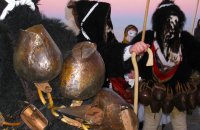
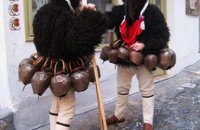
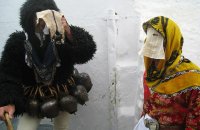
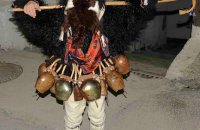
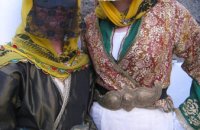
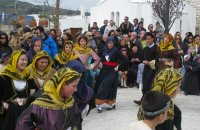
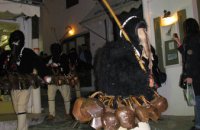
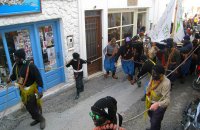
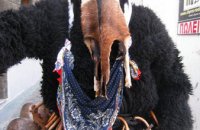
"Old Man", the "Girl", and the "Frank". . . it’s Carnival season on Skyros, and the custom has endured for centuries, with enthusiastic participants of all ages. It is the main event of the island, and known throughout Greece. Its origins are lost to history, however the first written reference to this unique custom appears circa 1900, by J.C. Lawson, and 1901, in the book The island of Skyros by Michael Konstantinidis.
The legend surrounding this ‘thunderous’ tradition is that a shepherd, having lost his sheep, girded himself with their bells and went wandering in search of them. The sound of a lone shepherd’s bells is one thing; the sound of dozens of bell-bearing “shepherds” is quite another!
Thus, the first custom you will encounter in the Skyros Carnival is that of the bell-wearers, a triad comprising the several traditional roles of the Old Man, the Girl, and the Frank. The main character of the triad is the Old Man, draped with dozens of large copper bells. He sways his midsection rhythmically, evoking an inimitable sound from his bells. The rest of his outfit, weighing in total close to 50 kg, consists of a black shepherd’s mantle, white woolen breeches, woven stockings with black garters, and of course the traditional sheepskin trochadia sandals typical of the island. As a mask to conceal his face, he wears the fleece of a newborn goat, in which a couple of holes have been made for his eyes. He takes up his staff, adorned with wildflowers, and begins his ambling tour of the region’s back-alleys. Accompanying him are the Girl, dressed in traditional Skyrian costume, and the Frank, who is dressed in European-style clothing and also wears a bell about his midriff.
Stopping every so often to make a characteristic gesture with his whole body, the Old man’s rhythmic pace and the gyration of his hips cause his bells to produce a terrific racket that will stay with you for some days to come. The Skyrians, honoring the tradition and caring for its preservation, teach the custom to their children from a young age; the youngsters donning a smaller version of the bells, or sometimes even old tin cans, to learn the correct execution of the traditional dance.
The Skyrian Carnival continues: following the Dionysiac ecstasy of the bells, the Skyros Carnival continues on Saturday afternoon with the Trata. In this we see elements of Carnival dress familiar throughout much of Greece, with the addition that the participants engage in the recitation of satirical verses. Skyrian and international, political and social developments all take their turn getting skewered for all to see.
We come to Clean Monday. (A point in the Orthodox Lenten season that does not have a direct equivalent in the Western liturgical calendar. It is somewhat analogous to Ash Wednesday, but observed a bit differently). The Skyrians, arrayed in traditional costume, sit about the tables that have been spread throughout the market district, enjoying certain ceremonial treats ahead of the long Lenten fasting period. These tables, the tsibousia, abounding with fresh seafood, traditional pies, delicate orchid bulbs, crispy lagana wafers, and of course, the freely flowing tsipouro liqueur (enjoy in moderation, and consider yourself warned!) are instrumental in recovering from the revelry of the past days.
Carnival on Skyros is sure to give you many images to describe, will remind you always of the beauty of this island paradise, end every time you hear the name Skyros, you will be inundated with sweet nostalgia.











